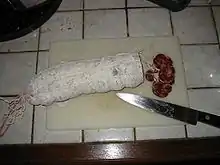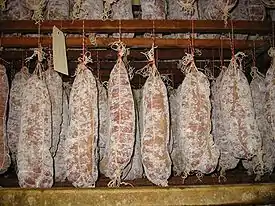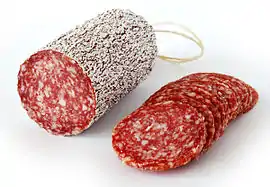Saucisson
Saucisson (French: [sosisɔ̃]) or saucisson sec is a family of thick, dry-cured sausages in French cuisine. Typically made of pork, or a mixture of pork and other meats, saucisson are a type of charcuterie similar to salami or summer sausage.[1]
 Sliced saucisson | |
| Course | Sausage |
|---|---|
| Place of origin | France |
| Main ingredients | pork |

Origin
Saucisson comes from the Latin salsus meaning salted. It is sometimes called saucisse sèche. There are saucisson recipes dating from Roman times, and Gaulish recipes for dried pork.
The word saucisson first appeared in France in 1546 in the Tiers Livre of Rabelais.
Production
Stuffing
Saucisson stuffing is generally made of two-thirds to three-quarters lean meat and the rest fat (largely pork back-fat called bardière). The mixture is ground to different fineness depending on the type of saucisson and mixed with salt, sugar, spices, nitrites and/or saltpeter, and with fermenting bacteria. For instance antilisterial strains of Lactobacillus sakei are used in Europe for the production of saucisson and can be used for the conservation of fresh meat.[2]
Some versions of saucisson also contain pepper seeds, garlic, bits of dried fruits or nuts (such as pistachios, figs, or olives), cheeses such as Roquefort, Laguiole, or alcohols such as wines or Génépi liquor.
See also
Further reading
References
- "Saucissons secs" (in French). Le Centre d'Information des Charcuteries-produits Traiteurs (Infocharcuteries). Retrieved 2013-09-16.
- Bredholt, S.; Nesbakken, T.; Holck, A. (2001). "Industrial application of an antilisterial strain of Lactobacillus sakei as a protective culture and its effect on the sensory acceptability of cooked, sliced, vacuum-packaged meats". International Journal of Food Microbiology. 66 (3): 191–196. doi:10.1016/S0168-1605(00)00519-5. PMID 11428578.

